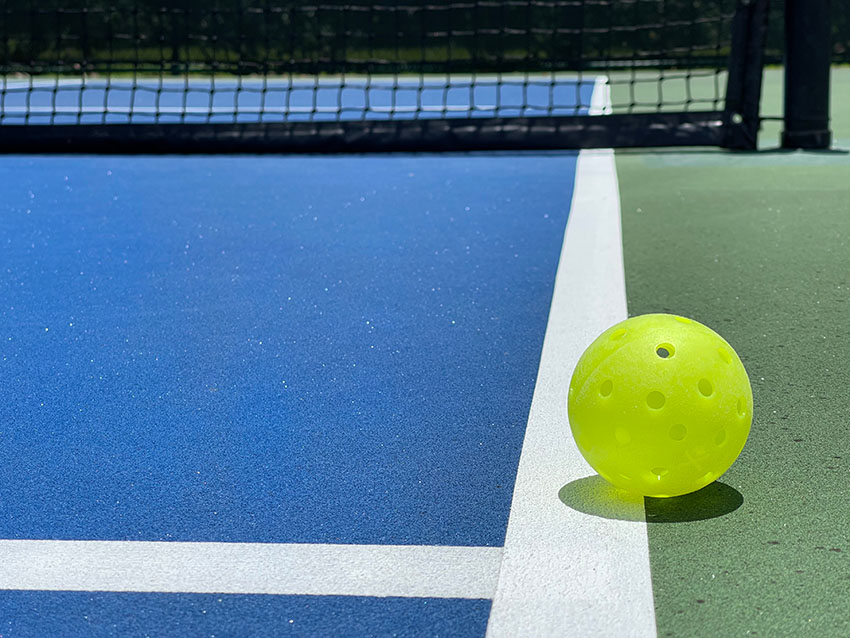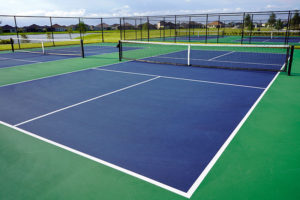Although it’s been around over 50 years, pickleball has really taken off in the last decade. The game was first invented in 1965 by three dads in the United States with bored kids. It’s a game played by young, old, and everyone in between. According to USA Pickleball, nearly 4.3 million Americans play regularly. Of that total, approximately 67 percent are 55 years old or older. Picking up any racket sport in middle age is not without risk. If you play or are planning to start, it’s important to do it safely.
Similar to tennis, you can play pickleball 1-on-1 or 2-on-2 on a smaller court that combines elements of badminton, ping-pong, and tennis. Because of the competitive nature of pickleball, one may suffer an injury to his/her lower back, hip, knee, and ankle as a result of strain or overuse. I know that we see quite a few wounded pickleball warriors in our practice. Part of the problem is that many players have a 20-year-old mindset inside a not so 20-year-old body. Rarely do these injured players make it a habit to warm up properly, they have a tendency to overdo it, and they rarely emphasize recovery. It’s a fun game, it’s a social activity, everybody loves it, but it’s easy to overdo it, especially when things get competitive.
How Injuries Occur
Any racket sport puts a lot of force on multiple different areas of the body. When you swing a bat, golf club or pickleball racket, your arms and hips are moving in many different planes of motion. Some muscles are forcibly contracting and shortening, while others are staying stationary and stabilized, while still others are lengthening simultaneously. Essentially, the muscles and tendons are being pushed and pulled at the same time. If they’re not up to the task, the muscle or joint can be overloaded and injured.
When we highlight upper extremity injuries, it all comes back to the kinetic chain. To swing the paddle, for example, rotation is generated in the hips and quads, transferred to the trunk, shoulder, arms and wrist. If anything goes wrong in any link of the chain, you can end up with inflammation, strain, pain or something worse in the shoulder or elbow.
The spine may receive the worst of the injuries for new pickleball players. Because pickleball involves a great deal of bending over/forward for long periods of time, the spine can easily be injured. The tighter the players’ hips and hamstrings, the more likely they are to injure the back, as extra stress is placed on the spine. It is important to note that warming up prior to playing for 10-15 minutes incorporating mobility, and flexibility exercises to increase blood flow and to loosen up your muscles and joints, are critical to preventing injury.
Injury prevention tips:
- Know your limits.
Walk off the court when you still feel good and not after you start feeling soreness or pain. - Go easy to start and build endurance slowly. If you’re new to the sport, find a good partner to begin hitting with for a few sessions before you start playing competitively.
- Warm up before hitting the court with a brisk walk, squats, or jumping jacks, then begin with some low-intensity play.
- Be especially careful when playing up a level—against opponents with more experience; it’s an easy way to get into trouble.
- Listen to your body—if any pain lasts more than 48 hours, it might be more than just sore muscles and it’s time to seek professional help. Don’t hesitate.
If one is to suffer an injury from playing, seek out help quickly. A qualified practitioner with experience in sports injuries can improve your recovery and reduce time away from the court. Often, our office will examine you thoroughly to determine the cause of injury and produce a rehab plan for you to follow. We will help you move better through chiropractic manipulation, exercises, acupuncture or dry needling, and Active Release Techniques (ART).
ART will help to improve mobility, flexibility, and subsequent function of the muscles and tendons in one’s hip, lower back, and knee. We work with injured players to discover movement dysfunctions and teach techniques to change how they move and avoid injury in the future. Moreover, chiropractic manipulation aligns and improves the health of the joints that are injured from playing pickleball. Lastly, corrective exercises will address muscle imbalances to make certain that new movement patterns remain and prevent overuse and injury.
These tools help you to prevent missing time from pickleball so you can become stronger, more stable, and healthier. This way you don’t have to limit your time away from the court. If you get injured playing pickleball, know that we can keep you in the game!
Opportunities for Trouble
“There’s a lot going on in that game. The court is smaller than tennis, so there’s more stops and starts. You’re swinging a paddle, which stresses the elbow, wrist and shoulder. And people tend to play hard, both men and women,” he says.
Mark says the advice to play safely is similar to any other sport:
Dr. Mark says an injury sustained in pickleball can be made worse by self-treatment. “Some players think they can tape themselves out of a jam with K-tape or they consult their playing partners or Dr. Google and decide they’re fine to get back in the game. This can be very wrongheaded and end up hurting you more,” he says.
“I see folks who have been suffering with tennis elbow for months. Had they come in earlier, we’d have had a lot easier time getting them back in shape. The longer you wait, the more intervention you’re going to need to get back in the game. Don’t put it off,” he says.
“Of course, on the physical exam, we’ll know pretty quickly if it’s something we can handle in the office or if you need more aggressive intervention. Generally speaking, it’s four to six sessions in the office, along with a regimen of stretching and strengthening done at home. We generally see improvement almost immediately and your doctor will work with you to develop a plan to train and return to play safety,” he explains.
Mark says pickleball is great exercise and a terrific way to keep your mind active—both extremely important for health at any age. But it’s easy to get ahead of your skill and get hurt—so play it safe.

Daryl C. Rich, D.C., C.S.C.S.








